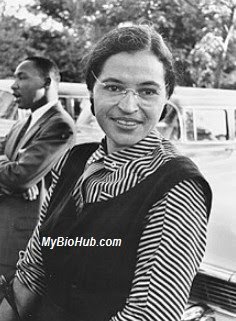Rosa Parks was born Rosa Louise McCauley in Tuskegee, Alabama, on February 4, 1913, In addition to African ancestry, one of her great-grandfathers was Scots-Irish and one of her great-grandmothers was a Native American slave. She was small as a child and suffered poor health with chronic tonsillitis. When her parents separated, she moved with her mother to Pine Level, just outside the state capital, Montgomery. She grew up on a farm with her maternal grandparents, mother, and younger brother Sylvester. They all were members of the African Methodist Episcopal Church (AME), a century-old independent black denomination founded by free blacks in Philadelphia, Pennsylvania, in the early nineteenth century
Parks‘ act of defiance and the Montgomery bus boycott became important symbols of the modern Civil Rights Movement. She became an international icon of resistance to racial segregation. She organized and collaborated with civil rights leaders, including Edgar Nixon, president of the local chapter of the NAACP; and Martin Luther King Jr., a new minister in town who gained national prominence in the civil rights movement.
After retirement, Parks wrote her autobiography and continued to insist that the struggle for justice was not over and there was more work to be done. In her final years, she suffered from dementia. Rosa received national recognition, including the NAACP’s 1979 Spingarn Medal, the Presidential Medal of Freedom, the Congressional Gold Medal, and a posthumous statue in the United States Capitol’s National Statuary Hall.
Until her death of natural causes on 24 October, 2005, she remained a resistant political analyst. She survived of her husband, Detroit. She and her husband never had children and she outlived her only sibling. She was survived by her sister-in-law (Raymond’s sister), several families relatives, and most of them residents of Michigan or Alabama.
Also Read: Esther Passaris Biography
If You Love Stories and Facts, Join this Whatsapp Channel




